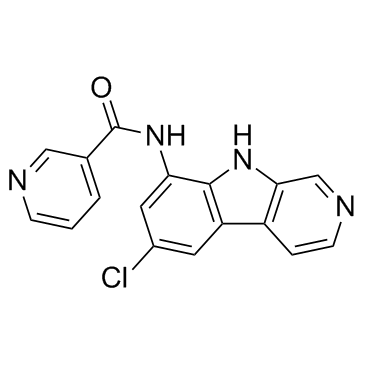| Description |
PS-1145 is an IκB kinase (IKK) inhibitor with an IC50 of 88 nM.
|
| Related Catalog |
|
| Target |
IKK:88 nM (IC50)
|
| In Vitro |
PS-1145 blocks TNFα-induced NF-κB activation in a dose- and time-dependent fashion in MM cells through inhibition of IκBα phosphorylation. Dexamethasone (Dex), which up-regulates IκBα protein, enhances blockade of NF-κB activation by PS-1145. PS-1145 blocks the protective effect of IL-6 against Dex-induced apotosis. TNFα-induced intracellular adhesion molecule (ICAM)-1 expression on both RPMI8226 and MM.1S cells is also inhibited by PS-1145. Moreover, PS-1145 inhibits both IL-6 secretion from bone marrow stromal cells (BMSCs) triggered by MM cell adhesion and proliferation of MM cells adherent to BMSCs[1].
|
| In Vivo |
Administration of either Bortezomib or PS-1145 (50 mg/kg) results in a significant decrease in serum levels of all 3 cytokines that is nonsignificantly different from those in mice that underwent transplantation with TCD BM alone[2]. PS1145 is injected intracerebroventricular (icv) as a pretreatment to block hypothalamic inflammation induced by IL-4 in adult male Wistar rats consuming a high-fat diet (HFD) over an 11-day period. The four groups of rats according to icv pretreatment/treatment condition are Veh/Veh, Veh/IL-4, PS1145/Veh, and PS1145/IL-4. Rats in the Veh/IL-4 group display increased weight gain on the HFD compared with the Veh/Veh group (P<0.05 on days 6-9). Importantly, the effect of icv IL-4 administration to increase body fat mass during high-fat (HF) feeding is completely blocked by icv PS1145 pretreatment at a dose that has no independent effect on body composition (on day 8: P<0.001, PS1145/Veh vs. PS1145/IL-4; P=not significant, PS1145/Veh vs. Veh/Veh). In PS1145/IL-4 injected rats, IL-1β mRNA content is decreased by ~75% compared with that of Veh/IL-4-injected rats[3].
|
| Cell Assay |
The inhibitory effect of PS-1145 on MM growth is assessed by measuring MTT dye absorbance of the cells. MM.1S cells are cultured for 48 h with 0.2 and 1 ng/mL TNFα, in the absence or presence of 2.5 μM, 5 μM, and 10 μM PS-1145. Cell viability is assessed by MTT assay. Cells from 48 h cultures are pulsed with 10 μL of 5 mg/mL MTT to each well for the last 4 h of 48-h cultures, followed by 100 μL of isopropanol containing 0.04N HCl. Absorbance is measured at 570 nm using a spectrophotometer[1].
|
| Animal Admin |
Mice[2] C57BL/6 (B6), B10.BR, and B6.SJL mice are used. Mice receive regular mouse chow and acidified tap water ad libitum. Bortezomib is administered intravenously to animals at a dose of 1 mg/kg, whereas PS-1145 is given intraperitoneally at a dose of 50 mg/kg. The first dose of each agent is administered before conditioning with total body irradiation (TBI). Rats[3] Weight-matched male Wistar rats (320-350 g) are used. Four groups of rats (n=6/group) consume the HFD for a 9-day study period. Animals in each group receive two consecutive icv injections three times/wk. Immediately prior to icv injection of IL-4 (100 ng) or vehicle, all animals receive a pretreatment icv injection of either the IKKβ inhibitor PS1145 (10 μg) or its vehicle (saline). Food intake and body weight are measured daily. Body composition analysis is conducted as above on days 0 and 8. On day 9, animals are euthanized and samples collected.
|
| References |
[1]. Hideshima T, et al. NF-kappa B as a therapeutic target in multiple myeloma. J Biol Chem. 2002 May 10;277(19):16639-47. [2]. Vodanovic-Jankovic S, et al. NF-kappaB as a target for the prevention of graft-versus-host disease: comparative efficacy of bortezomib and PS-1145. Blood. 2006 Jan 15;107(2):827-34. [3]. Oh-I S, et al. Central administration of interleukin-4 exacerbates hypothalamic inflammation and weight gain during high-fat feeding. Am J Physiol Endocrinol Metab. 2010 Jul;299(1):E47-53.
|
